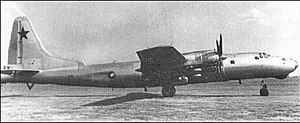Tupolev Tu-80
| Tu-80 | |
|---|---|
 |
|
| Role | Heavy bomber |
| National origin | Soviet Union |
| Manufacturer | Tupolev |
| First flight | 1 December 1949 |
| Status | canceled |
| Number built | 1 |
The Tupolev Tu-80 was a Soviet prototype for a longer-ranged version of the Tupolev Tu-4 bomber built after World War II. It was canceled in 1949 in favor of the Tupolev Tu-85 program which offered even more range. The sole prototype was used in various test programs before ending its days as a target.
The Tu-80 was designed as a modernized and enlarged Tu-4 with greater range. This was to be achieved by the use of more fuel-efficient engines, better aerodynamics and adding fuel tanks. It was intended to have a range of 7,000–8,000 kilometres (4,300–5,000 mi) and carry a maximum bomb load of 12,000 kilograms (26,000 lb) with a top speed of 620 kilometres per hour (390 mph). Work began on the design in February 1948 and this was confirmed by a Council of Ministers order of 12 June that required the prototype be ready for State acceptance trials in July 1949.
The forward portion of the fuselage was redesigned with an airliner-style stepped windscreen and the fuselage was lengthened by almost 4 m (13 ft) which allowed the bomb bays and their doors to be lengthened. The radar and its operator were moved into the forward pressurized compartment and the radar itself was located in the "chin" position in a new streamlined fairing. The wings were enlarged to a total of 173 square metres (1,860 sq ft) and the rubber deicing boots were replaced by more efficient and aerodynamic bleed air deicers. The engine nacelles were redesigned with smaller cross-sections with less drag. Originally Shvetsov ASh-2TK or Dobrynin VD-3TK engines were considered, but neither engine was ready so the Shvetsov ASh-73TKFN was used. Fully feathering propellers were also used. All of these changes increased the lift/drag ratio to 18 from the 17.0 of the Tu-4.
Construction of the Tu-80 began in November 1948, using as many Tu-4 components as possible to speed up construction, but the first flight wasn't until 1 December 1949, after the Council of Ministers had canceled the program on 16 September 1949 in favor of the Tu-85 which was expected to have much better performance. The Tu-80 became a research aircraft, testing reversible-pitch propellers and structural deformation in heavy aircraft. It eventually became a target on a bombing and gunnery range.
...
Wikipedia
